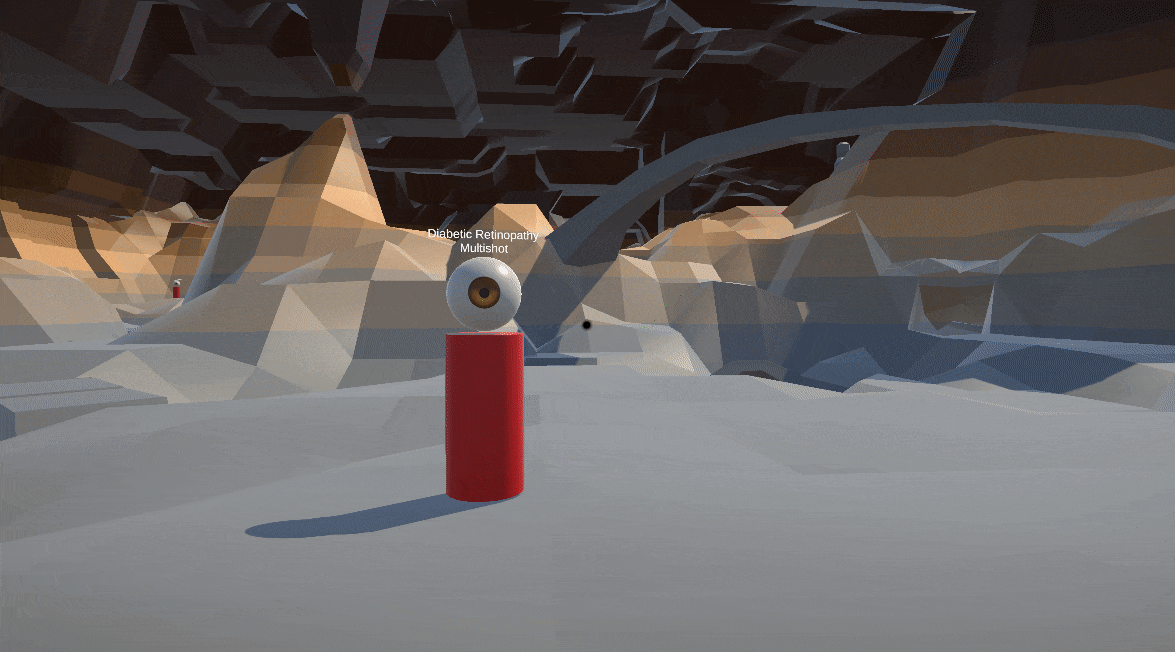Overview
The Blind God is a single-player first-person shooter game developed in Unity in which you protect a shrine from waves of enemies. It has light deckbuilding mechanics in the form of an eyeball collection that you create over time, each eye giving you a type of sight loss (simulated on the screen), as well as a boon granted by the blind god. The greater the sight loss, the greater the boon.
Developers:
-
Jack Teviotdale: 3D Environment Artist.
-
James Patrick Conroy: Audio Designer.
-
Niko Drousie: Game Designer & Programmer.
-
Paige Wilkie: 3D Character Artist.
My research focuses on making a game that is playable for both players with and without sight loss by implementing accessibility features, and on using gameplay to raise awareness and improve representation of characters with sight loss in games. I focused on designing features and gameplay that could help the industry improve in both of these areas.
Navigating with Sight Loss

A sonar was developed to help with local navigation - obstacles, hazards, and enemies - in video games with a first-person perspective, mimicking to some extent the ultrasonic or infrared sensors used by blind people for navigation in the real world. This sonar rotates around the player and when it hits something, a sound is played from that position, allowing players with sight loss to locate and avoid obstacles, as well as giving them an idea of the size and shape of the object as they navigate around it. Multiple settings can be adjusted, like the range, speed, and subdivisions of the sonar.

This sonar system was designed to be a time- and cost-efficient system to implement for any development team, with the goal to provide a new tool to improve the knowledge on accessibility features for players with sight loss in the industry. Non-linear games would be the ones that would benefit the most from this, as linear games could instead benefit from less crowded ping systems like the one in Gears of War 5. However, before this system can be used by the industry at large, further research and iteration will be required to solve some of the remaining issues: pits, jumpable gaps, and font vs. back distinction.

Read the full post-mortem for more details and information.
Simulating Sight Loss

One of the goals of The Blind God was to simulate sight loss to increase awareness and literacy on the subject. To do this, the game used a first-person camera perspective and added a deckbuilding element, an eye collection that you expand wave after wave in a similar style to Slay the Spire. These eyes can be activated to give you a new type of sight loss and a buff, or to increase an already existing one, as seen in the following in-development example.

This allows the game to teach players about a range of conditions as well as different levels for each condition, increasing awareness overall, focusing on the most common ones: glaucoma, macular degeneration, and diabetic retinopathy. A cataracts simulation was attempted, but it was found to be innacurate based on expert feedback and would need to be reworked before making it into the game.




As a consequence of sight loss simulation being core to the gameplay design, sighted players also benefited from accessibility features meant for players with sight loss, and some players were even seen using similar coping mechanisms while playing as people with sight loss use in their daily life. Similarly, blind players are at an advantage in later stages of the game, as they can activate as many buffs as they want without suffering any of the drawbacks. Despite this, more work is required, as the blindness and buff type should be read by a narrator through text-to-speech, and the simulations could be improved and expanded upon.
Read the full post-mortem for more details and information.
Other Highlights
The development of The Blind God required a lot of work that was not directly relevant to the research - level design, procedural animation, narrative cohesion... - 0r that didn't make it into my post-mortem as it was mostly the audio designer James Patrick Conroy's work - aiming audio assistance -.
Check this Twitter thread to see my development progress updates over time.


